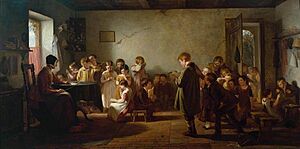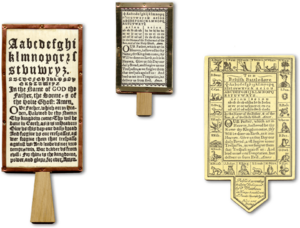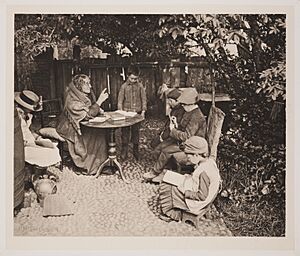Dame school facts for kids
Dame schools were small, private schools for young children in Great Britain and its colonies. They started a long time ago, from the 1500s to the mid-1800s. These schools were run by a local woman, often called a "school dame." She would look after children and teach them basic things for a small payment.
Children usually went to dame schools between the ages of two and five. They learned reading, simple math, and sometimes writing. Girls often learned useful skills like knitting and sewing. Dame schools were like the early versions of today's nursery and primary schools. Many famous people, like the poet William Wordsworth, even attended them!
Contents
What Were Dame Schools Like?
How Dame Schools Started
No one knows exactly when dame schools began. They likely grew naturally because families needed affordable childcare and basic education. Most dame schools were held in the teacher's own home.
These schools were run by women in their local areas. They were not part of a big system. Many teachers were widows, older unmarried women, or young women who needed extra money. Sometimes, men also taught at these schools.
Learning at Dame Schools
School dames charged very little for their lessons. For example, one teacher in Darlington, England, received about four shillings a year per student. This was a small amount, roughly equal to four days' pay for a skilled worker back then.
Children of tradesmen and working parents often attended dame schools. For many, this was the only education they ever received. Teachers would hold classes for several hours each day. They taught reading and writing, often using a hornbook. A hornbook was a flat piece of wood with a printed sheet of paper on it, protected by a thin layer of animal horn.
In those days, reading and writing were taught separately. More children, both boys and girls, learned to read. However, writing was often taught mostly to boys. Learning to read the Bible was very important, so reading was always encouraged. Some teachers also taught religious lessons or invited a local church leader to help.
Basic math was also taught, helping children learn how to manage household money. Girls especially learned knitting, which was a valuable skill for their future.
How Many Dame Schools Were There?
By the 1700s, dame schools were common across England. It's hard to know exactly how many there were because they were informal. Teachers didn't need special licenses like other school masters. For example, in one survey of villages in Yorkshire, only about one in forty had a documented dame school.
Changes in the 1800s
Dame Schools and the Industrial Revolution
The Industrial Revolution changed many things, including dame schools. As more parents worked in factories, dame schools became important for cheap childcare. Some schools focused only on childcare, while others still offered education.
The Sunday school movement also grew in the 1800s. These schools were similar to dame schools, offering basic reading and religious lessons on Sundays. Despite these changes, many dame schools continued to teach basic skills for a small fee.
Views on Dame Schools
During the 1800s, people started to have different opinions about dame schools. Social reformers wanted a national, standardized education system. They often saw dame schools as not good enough. They said these schools couldn't teach children useful skills.
However, some historians believe this view isn't fair. Dame schools were run by working-class women for working-class families. They were informal and felt more familiar to parents. This gave parents more control over their children's schooling, which was different from the new schools run by middle-class officials.
In 1861, a group called the Newcastle Commission looked at schools across Britain. They found that many children attended private schools, including dame schools. The commission said that dame schools didn't prepare children well for life.
Because of this report, the Elementary Education Act 1870 was passed. This law created a framework for schooling all children aged 5 to 12 in England and Wales. After this law, most dame schools closed because new, formal schools became available.
Even as late as 1850, about 30% of all children still attended dame schools.
Famous People Who Attended Dame Schools
- William Wordsworth: This famous poet went to a dame school in Penrith, Cumbria. He even met his future wife there! He said his dame school taught reading and helped improve memory.
- John Keats: Another well-known poet, he attended a dame school in London.
- Oliver Goldsmith: He learned his letters from Mrs. Delap at her dame school.
- Charles Dickens: The famous author of Great Expectations went to a school run by a mistress in Chatham, Kent. In his novel, the character Pip attends a dame school that is described as not very useful.
- William Shenstone: He wrote a poem called The Schoolmistress, A Poem based on his own experience at a dame school.
- George Crabbe: He also wrote a poem about his dame school experience in his book Poems: Volume 1.
Dame Schools in North America
In Colonial America, dame schools were also small private schools run by women. They taught basic reading, writing, and arithmetic. For wealthier girls, they might also teach French, dancing, singing, and embroidery.
The quality of education varied. Basic dame schools were more common in New England. There, it was important for everyone to learn to read, especially for religious reasons. The Massachusetts School Law of 1642 and the Old Deluder Satan Law required children to learn to read the Bible. Dame schools helped families meet this requirement.
For a small fee, women (often housewives or widows) would teach children basic reading, writing, prayers, and religious beliefs. They accepted payments in money, homemade goods, or other items. Teaching materials were simple, usually a hornbook, a primer, a Psalter, and the Bible. Both boys and girls attended these schools.
Dame schools focused on the "four R's": Reading, Riting (writing), Rithmetic (arithmetic), and Religion. Girls might also learn sewing and embroidery. For many girls, this was their only formal education. After dame school, boys from wealthier families often went to grammar school to learn more advanced subjects like Latin.
In the 1700s and 1800s, some dame schools offered a "polite education" for children from rich families. These schools taught reading, writing, English, French, arithmetic, music, and dancing. Schools for upper-class girls were often called "female seminaries" or "finishing schools."
Dame Schools in Australia
The very first known school in Australia was started in Sydney in December 1789 by Isabella Rossen. Another early school was founded by Mary Johnson in Parramatta in 1791. Both of these women were convicts who were supervised by a clergyman.
See also
- History of education in England
- Public school (United Kingdom)
- Education in early modern Scotland
- History of childhood care and education
- Education in the Thirteen Colonies
- History of education in the United States




